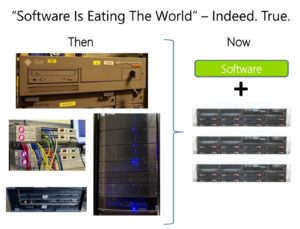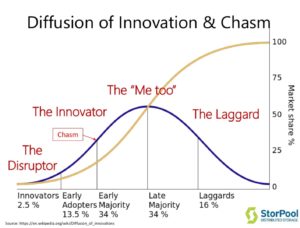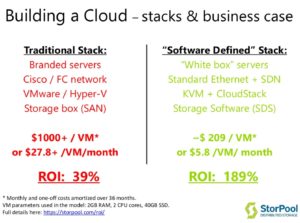In his recent talk Boyan Ivanov, CEO of StorPool Storage gave the audience useful tactical pieces of advice on how to build a software-defined cloud.
The software is “eating” the world
The truth is the world is rapidly adopting all sorts of software-defined solutions. The software is for sure the new norm. Everything is becoming simpler, smaller, and more friendly to the end-user. And, of course, everything is moving to the cloud. The cloud, however, is not changing – it is and will remain the same old server, that runs your applications. Therefore, the infrastructure is not going away. It’s simply becoming more hyper-converged, putting various services on the servers – networking, storage, and workloads in order to make the IT stack more efficient.
Why using a hyper-converged cloud?
- Get a competitive advantage – by switching to a hyper-converged cloud you gain better performance, quality of service, higher availability, redundancy, etc.
- To directly boost your bottom line – One more thing to achieve with the hyper-converged cloud is to significantly reduce costs, as well as provide new services.
The 4 types of companies on the market
 You can differentiate 4 main types of companies on the market – the Disruptor, the Innovator, the “Me too”, and the Laggard. Disruptors are the ones who take the industry by storm. What they do is hard to both emulate and repeat. You may see them in the face of Digital Ocean, AWS or GOOG. The Innovators on the other hand constantly improve their business process and technology. They never stop looking for a way to satisfy the needs of the market or the customer. They are not afraid to push the limits. The Innovators are the opposite of the “Me too” companies. They tend to follow the trend, play it safe and do everything the Disruptors and the Innovators try to avoid. The Laggards are quite similar as well. They are resistant to change and innovation, lacking the vision, mindset, and strategy to better their business. Therefore, the last two mentioned group usually fall behind and don’t last in the long run.
You can differentiate 4 main types of companies on the market – the Disruptor, the Innovator, the “Me too”, and the Laggard. Disruptors are the ones who take the industry by storm. What they do is hard to both emulate and repeat. You may see them in the face of Digital Ocean, AWS or GOOG. The Innovators on the other hand constantly improve their business process and technology. They never stop looking for a way to satisfy the needs of the market or the customer. They are not afraid to push the limits. The Innovators are the opposite of the “Me too” companies. They tend to follow the trend, play it safe and do everything the Disruptors and the Innovators try to avoid. The Laggards are quite similar as well. They are resistant to change and innovation, lacking the vision, mindset, and strategy to better their business. Therefore, the last two mentioned group usually fall behind and don’t last in the long run.
Building a cloud – stacks & business case
What is, in fact, driving the whole software-defined data center concept? The answer is pretty straight-forward – it’s the cost. StorPool presents a business case which shows very clearly the difference between the Traditional Stack and the Software-defined Stack. The already painfully familiar Traditional Stack has been in use for more than two decades. And, as shown below, it results in significantly lower ROI (39% in this case). Today, however, a lot of people are using “White box” servers, standard Ethernet, etc. to build the cloud of the 21st century. In this case, the ROI reaches 189% – the difference is staggering.
Some tactical tips
- For hypervisors – use higher density hypervisors with 32-36 cores (E6-2697v4). Better unit economics ($/VM);
- Put loads of RAM – 512GB. For running VMs, RAM is the usual bottleneck;
- Avoid BASE-T – Switch to SFP+
If you have any questions feel free to contact us at info@storpool.slm.dev



